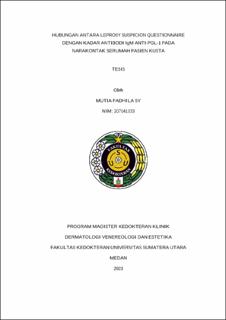| dc.description.abstract | Background: Leprosy is a chronic granulomatous disease affecting mainly the skin and peripheral nerves caused by the obligate intracellular pathogen Mycobacterium leprae (M. leprae). Contacts who live in the same house as untreated leprosy patients have the highest risk of contracting leprosy. Developments of leprosy research have increased in recent years. There is an active leprosy search strategy by providing the Leprosy Suspicion Questionnaire (LSQ) containing 14 simple questions about the symptoms and signs associated with leprosy. This technique increases the chances of early diagnosis and treatment. In addition, the chemical structure of an antigen, namely phenolic glycolipid 1 (PGL-1), has been discovered, resulting in a revolution in serodiagnostics of leprosy. The contacts who have positive anti-PGL-1 levels have up to an 8-fold higher risk of developing leprosy.
Objective:To determine the relationship between LSQ and anti-PGL-1 IgM antibody levels in household contacts of leprosy patients.
Method:This research is an observational analytical study with a cross-sectional approach. Sample consisted of 30 subjects who were household contacts of leprosy patients. Examination of anti-PGL-1 IgM antibody levels using the ELISA method was carried out at the Cito Laboratory, Yogyakarta.
Results:In terms of demographic characteristics, there were 18 female subjects (60%), while there were 12 male subjects (40%). LSQ+ results were found in 22 (73.3%) subjects, while LSQ- results were found in 8 (26.7%) subjects.The results of the anti-PGL-1 IgM examination were classified into 3 categories, namely seronegative (<605 U/mL) totaling 25 people (83.3%), low titer seropositive (605–1000 U/mL) totaling 4 people (13.3 %), and high titer seropositivity (>1000 U/mL) was 1 person (3.3%). The mean value of IgM anti-PGL-1 was 383.63 U/mL with the lowest value being 0 and the highest being 1593 U/mL. Using the Fischer's Exact showed that there was no relationship between LSQ and IgM Anti-PGL-1 (p=0.287).
Conclusion: There was no relationship found between LSQ and anti-PGL-1 IgM antibody levels in household contacts of leprosy patients. The results of the LSQ answers correlated with anti-PGL-1 IgM antibodies found in only 5 subjects. | en_US |





